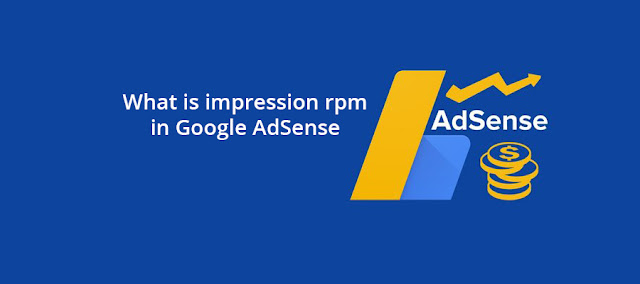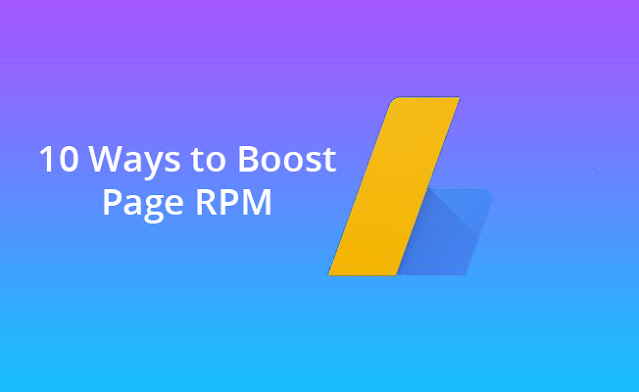
What is impression rpm in Google AdSense _Know Step by Step- USA 2021
10 Strategies to Increase Page RPM
Publishers have a number of tools at their disposal to help them achieve and maintain revenue growth. Page RPM is one of the key metrics they can monitor and influence. It is also an important metric for detecting problems with ad effectiveness. Although RPM is a volatile metric, there are a number of strategies you can use to influence it and increase your overall advertising revenue.
What exactly is Page
RPM?
Page RPM is an abbreviation for Revenue per Mille, also
known as Revenue per Thousand, and is a digital advertising metric used by
publishers to estimate the revenue a site can generate for every thousand page
views.
In contrast, eCPM is an abbreviation for "effective cost
per mille." It is used on a variety of platforms that monetize through
display ads, such as desktop, mobile, in-app, and video. It is critical to
understand that page RPM and eCPM are essentially interchangeable. As a result,
Google interchangeably uses the terms.
How to Determine Page
RPM
Page RPM is calculated by dividing your estimated earnings
or ad revenue by the total number of page views and multiplying by 1000:
Page RPM = (estimated earnings / total number of page views)
multiplied by 1000
For example, if you get 1500 page views per month and your
ad revenue is estimated to be $15, your page RPM is ($15/1500)*1000 = $10.
What Factors
Influence Page RPM?
There are two metrics that have a direct impact on your RPM:
1. The rate of
click-through (CTR)
This metric counts the number of ad clicks per thousand ad
impressions. The more often an advertiser's ads are clicked, the more
publishers are compensated. In a nutshell, increasing CTR leads to increased
page revenue. A higher CTR also indicates that the publisher is providing a
high-quality placement for those types of ads, allowing the publisher to charge
a higher price per click on the ad placement bid.
2. Pay-per-click
(CPC)
This metric measures how much money an advertiser is willing
to pay for a click on an ad on a publisher's website. CPC varies depending on
the ad's content, context, and niche.
Publishers should keep their CTR and CPC as high as
possible, as increasing these two metrics will drive the growth of their page
RPM.
There are a number of strategies that publishers can employ
to improve the effectiveness of their advertising real estate. Here are some of
the most effective methods for publishers to increase page RPM.
10 Ways to Boost Page RPM
The actions you take to boost your page RPM will not always
have an immediate impact. When conducting A/B tests to implement any of these
recommendations, use a significant sample size and allow each experiment to run
for at least a week before evaluating the results.
To improve page RPM, you can focus on three main areas: your
own website, the ads that appear on your site, and the audience that visits
your site.
1. Concentrate on the
quality of your content.
At this point, it may sound cliche, but focusing on content
quality is the foundation that will allow you to command a higher page RPM.
Having high-quality content that your audience cares about has a cascading
effect on all other metrics and optimizations. True, having great content isn't
a surefire way to success. We've all heard of great publications that went out
of business after producing high-quality content in their respective fields.
But consider this: how many successful, long-lasting websites do you know that
have poor content?
2. Suggest relevantly
content to keep users engaged.
Content recommendation engines are intended to provide users
with navigational pathways to related content in order to keep them engaged and
increase their time on page and across the site. Increasing the number of page
views will increase your page RPM because it increases the likelihood that the
user will click on an ad.
3. Improve site speed
and resolve technical issues
Improving user experience and ad viewability requires
increasing the loading speed of your site and ads. However, you should also be
aware of any other technical issues that may impair your performance, such as
mobile rendering issues or broken links. These technical issues have a
cumulative negative impact on your SEO efforts, affecting your page RPM as
well.
4. Improve ad
visibility
How effective is an ad that the user does not see? Not very
efficient. Advertisers and publishers are increasingly using this metric to
evaluate ad campaigns. Advertisers are increasingly opting to pay only for
viewable impressions. According to E marketer, ad viewability on a desktop
computer is around 50%. This means that nearly half of all advertising dollars
are spent on ads that are never seen by anyone. This means that if the industry
switched overnight to only paying for viewable impressions, publishers would
lose a significant portion of their revenue. As a result, it is in everyone's
best interest to take steps to improve ad viewability.
According to our findings, there is a strong correlation
between ad viewability and CPM, which means that increasing viewability will
have a direct impact on your page RPM. One factor that can affect ad viewability is reducing ad latency (increasing ad loading speed). Improving ad
layout and placement can also help you increase ad viewability.
5. Make your ad
formats and sizes as effectively as possible.
You can accept a variety of ad formats on your website,
including text, display, video, rich media, and expandable ads. Some ad formats
are more expensive per click and impression. This is not to say that switching
all of your ad inventory to video ads will allow you to increase your page RPM.
You'd have to experiment to find the best combination of formats for maximizing
your ad revenue.
There are also various ad sizes that are defined and
standardized by industry bodies such as the IAB. The Interactive Advertising
Bureau published guidelines in 2017 that are based on image proportions rather
than fixed sizes. Some ad sizes are more commonly used by advertisers,
resulting in increased competition. Implementing these ads would increase the
CPC of your ads, resulting in higher page RPM. Some ad sizes are also more
effective than others and have higher CPCs. You should conduct your own
experiments to determine which ad size works best for you, but in general,
larger ad sizes have a higher CPC.
6. Experiment with
different ad networks.
Fill rate is a metric used in online advertising that describes
how many ad placements a publisher can fill with advertisements. To maximize
your revenue potential, you should aim for a high fill rate. It is impossible
to achieve a 100% fill rate due to external factors such as network issues or a
visitor leaving the site before the ad has had time to load. Working with an ad
server that allows you to diversify your ad providers is one strategy for
increasing your fill rate. You could start with your own direct campaigns and
then fill the remaining ad placements with various ad networks. This allows you
to serve the most profitable advertisement in each case while also increasing
your fill rate by giving you multiple options for where to serve an ad.
7. Employ header
bidding.
Header bidding is a programmatic advertising technique that
allows you to sell your ad space to multiple ad networks, who then compete for
the right to place an ad in your content. Allowing ad exchanges to compete for
ad placements is an efficient way to increase your advertising revenue. Instead
of selling your inventory to the largest ad exchanges, as was traditionally
done with the waterfall model of ad selling, you sell your space to the
exchange with the highest bidding. Ad loading times will be reduced by
switching from waterfall to header bidding, increasing ad viewability and
effectiveness.
8. Carry out ad
refresh
You can serve multiple ads on the same advertising placement
to the same user using ad refresh. When a condition is met, which could be time
on-page, a visitor action, or any other event, the current ad is refreshed and
replaced with a different ad. Only refresh the ad units that the user is
currently viewing. Even though the CPM for those impressions will be lower than
for the first ad served, your page RPM will increase.
9. Ensure that the
ads are relevant to your target audience.
Setting up the proper targeting for your users is an
important step in increasing your page RPM. Displaying relevant ads to your
target audience boosts their effectiveness because they are much more likely to
click on an ad. To increase the relevancy of your ads, you can set up different
targets for different sections or topics on your website.
10. Provide your
readers with an excellent user experience.
Your visitors did not come to your website to be bombarded
with advertisements and notifications. They came to view and consume the
content you produce. It is difficult to quantify and measure, but a positive
user experience will increase your audience's engagement and loyalty. Bounce
rate and repeat visits are two metrics you can track to see how your user
experience is improving. Visitors who return will increase your page RPM over
time. It's a more sustainable strategy than suffocating your audience with ads
or implementing obtrusive ad formats that disrupt the user's task.
Why does the page RPM fluctuate?
Page RPM fluctuates and varies as an estimated metric, so it's important to monitor trends and use rolling averages rather than focusing on day-to-day metric updates. Any change you make will take some time to affect your RPM, so allow enough time for each optimization to be evaluated. In any case, you should never stop experimenting, testing, analyzing, and optimizing.
Remember that page RPM is only one aspect of the story. For example, a decrease in page RPM could result from an increase in traffic, which would increase your overall advertising revenue. Combine page RPM with other metrics to get a comprehensive picture of your site's success and ways to increase advertising revenue.
FAQs
What Does a Good Page RPM Mean?
The quality of your page RPM varies according to your publisher's niche, content, demographics, traffic quality, geo-location, and seasonality. RPM can generally range from $0.05 to $50 and up.
What exactly is RPM AdSense?
RPM on AdSense calculates the estimated ad revenue and ad impressions that a publisher can earn per thousand impressions.
CPM vs. RPM
While page RPM is a publisher metric that measures estimated earnings and ad impressions per thousand page views, CPM is an advertiser metric that calculates the estimated cost per thousand ad impressions.
What exactly is Impression RPM?
Impression RPM is calculated simply by dividing total ad revenue by total measured ad impressions and multiplying by 1000. The only difference between it and CPM is that it is used by publishers and primarily on AdSense, whereas CPM is from the perspective of advertisers.


0 Response to "What is impression rpm in Google AdSense _Know Step by Step- USA 2021"
Post a Comment